I’ve had enough. I’m tired of constantly explaining that the Sakonnet River Race takes place in the ocean. One year I had T-shirts printed up that said “The Sakonnet River Isn’t”, but this might have been too subtle – people kept spinning me around by my shoulders to read the rest on the back. Taking a page from forward-thinking sportswriters (and now the organization itself) who took to referring to the NFL franchise as the “Washington Football Team”, I’ll henceforth be conscientiously omitting the offensive R-word nickname from references to the Sakonnet Race. It strikes me that by creating a goofy analogy to a serious social issue, I might myself be guilty of gross insensitivity. Better hold off on that new mascot I was going to propose for the race.
Since its 2008 inception, the Sakonnet Race has started at McCorrie Point. Plagued by inconsiderate out-of-town visitors to that beach, locals successfully petitioned the municipality to limit parking to residents only starting this year. Wesley was among the group wanting to limit access to his back yard launch – I’m guessing he was getting tired of the horde of fishermen taking bets on whether they could snag his boat as he paddled by. By shutting down the beach to non-residents, however, he had successfully hoisted himself (and the race) with his own petard. He’s been experimenting with exotic new safety leash systems this season, so I can’t say I’m that surprised at this mishap. At least until he can get a waiver for the rule he himself had championed (wait… where have I heard that recently?), we’ll be running an alternative course for the race.
For 2020, the start would be from Island Park Beach, located at the north end of the bay. We’d proceed 4.6 miles out of the bay along its western shore, casting wistful glances at McCorrie Point roughly 3 miles into the trip (with the fishermen likely casting lead right back). We’d then turn on a “No Wake” buoy near Sandy Point and head back to the start. With a steady 15 mph wind from the north, the initial downwind leg would pass in a flash, while the return trip would, by my watch, still be underway now. We’d actually covered the same water in two weather-adjusted previous Sakonnet races, but by starting at McCorrie rather than at an endpoint, the upwind slog was split into two more manageable segments separated by a long downwind leg. This year there was no installment plan – the bill would have to be paid in one lump sum.
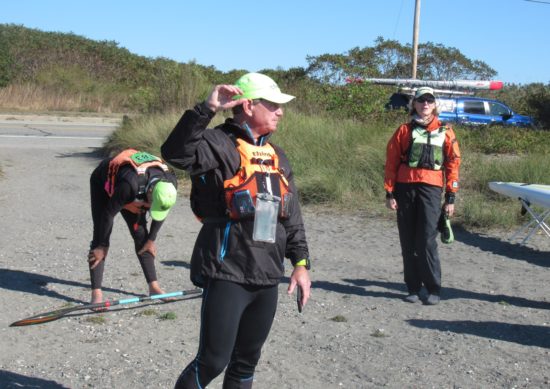
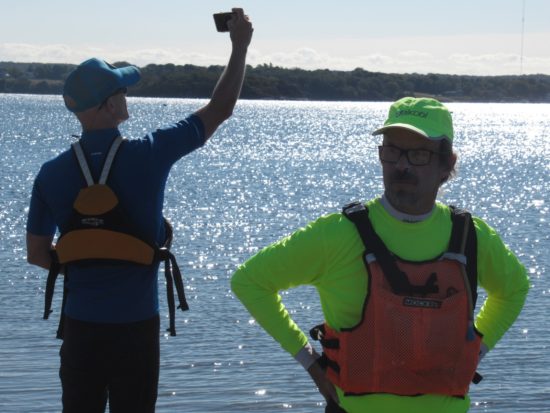
At the end of August, some higher-up in the Meteorology Department had “accidentally” flipped his calendar directly to October to get to that adorable photo of otters having a tea party (to be fair, September’s road-kill possum tableau was a real downer). As a result, after strapping the boats on the car we had to swing by the emergency room so that I could have a couple of frost-bitten fingers amputated. Don’t worry – it wasn’t the best ones. The Doctor (if that was even his real name) expressed some doubt that 42 degrees was sufficient to do lasting tissue damage, but I told him to shut up and keep sawing.
By the time we reached Island Park Beach, the temperature had increased enough that I could finally move again, although most of that movement was confined to uncontrollable shivering. Jim Hoffman asked if I wanted to borrow some warmer clothes, but he was unable to discern if I was shaking no or nodding yes. When he graciously repeated the offer after the race, I got wise and blinked once for yes. As we all know, Jim was inadvertently dropped into a vat of Human Growth Hormone as an infant, after which a well-meaning lab technician popped him into the gamma-wave chamber to dry him off. That’s why he has to buy all his clothes from Linebackers-R-Us and can melt titanium with his thoughts (oddly enough, only titanium – so unless you have an artificial hip, you’re probably safe). I was grateful for the loaner fleece, but had to keep the hood up over my head to prevent my shoulders from sliding through the neck hole.
With Rhode Island restricting outdoor gatherings to 15 people, we had a cozier than normal crew for the Sakonnet Race. In addition to a nice sampling of regulars from Greater New England, we had a delightful smattering of irregulars from regions beyond – John Costello (NJ), Melinda Schlehlein (NJ), and John Redos (PA). Given that conditions would vary so much during the race, it was tough to handicap the field. I had a particular respect for Tim Dwyer, though. He’s had a solid season, sure, but more importantly, he’s consistently exhibited an almost pathological lack of concern for paddlers in distress – a critical component to success when you’re in a race in which some poor sap is likely to be floundering beside my, er, his boat. For months after the 2018 Gorge Downwind Champs, I’d awake screaming “Tim! For Pity’s sake, don’t leave me, Tim!”


Once Wesley had gathered us around and sworn us in as deputies (I assume – I was fiddling with my hydration system during the meeting), we hit the water and lined up for the start. I would have put my money on Chris Chappell to jump out to an early lead, but even at very generous odds, nobody is taking that bet anymore. Tim and Wesley had fine starts in direct pursuit of Chris, with John moving swiftly from the right of the line. I had a decent enough start to merit some back-handed compliments from the field as I pulled even with the leaders. As I recall, something vaguely like “Tim, will you check me for weeds? Because there’s no other way Listless Lesher could have already caught me.” Now that I see it verbatim in writing, seems more like a fore-handed insult. In any event, I showed those guys by inching forward at an almost imperceptible rate.
As we moved further from the lee of the shore, the conditions gradually transitioned from flat to rideable waves. To reach that state of downwind maturity, however, you had to make it through that awkward adolescent period where you bumble through waves that somehow aren’t big enough to push you along, but are substantial enough to be difficult to get over. At 1.75 miles, my GPS track show an almost instantaneous increase of a half mile an hour in speed as the waves finally fleshed out. They’d continue to evolve for the remaining trip to the turn-around, although based on post-race reports from my competitors, I may have stunted their development by taking an inside line that needlessly limited nourishment from both wind and tide.
Even though Wesley had thoughtfully sent us photos of the turn-around buoy taken from Sandy Point beach, I had trouble locating the scamp from the water. My inside line had left me unexpectedly shoreward of the buoy. I was just preparing myself for a peek-a-boo search through a small field of moored boats when I spotted the marker 100 meters off my port quarter. I wheeled my V10 through a graceless arc towards the turn, noting with some alarm that the beam traversal was quite lively. The first half of the race had left me giddy with glee, but the incoming waves quickly slapped the grin off of my face. Just a moment after I had managed to turn back fully into the wind and round the buoy, an exuberant Tim came sailing by on the last run of his downwind leg. Despite having only been thrust into an epoch of unrelenting toil about 20 seconds ago, I was already pining for that bygone era of untroubled surfing joy.
The first half-mile back towards the start was a sobering exercise in growing dread. Having perhaps put a little too much gusto into the previous 35 minutes, I was now getting man-handled by the conditions. My majestic plunges while running with the waves had been replaced by a series of semi-controlled flops over an endless series of jagged crests. Another 4.5 miles of this would be intolerable. For the first time ever, I felt like my damnable GPS had taken pity on me and was actually exaggerating my speed to boost my spirits. A nice gesture, sure, but may I suggest picking a number larger than 4.4 next time? Fortunately, as I moved more into the lee of McCorrie Point, the violent see-sawing abated enough that I could break the mystical 5 mph barrier.
I was initially concerned that Tim’s superior rough water abilities would allow him to close the meager gap that I had established in the downwind leg, but as conditions flattened into more of an upwind grind, my baseless (wait… what?) confidence that I’d persevere grew. Just about the time I had reached “cocksure” levels of arrogance, I happened to glance shoreward. If it hadn’t been for the neon yellow stickers on Tim’s deck, I never would have spotted his shadowy, slinking profile. But there he was, dead even on an inside line. I responded to this horrific discovery with characteristic aplomb, limiting myself to only two or three shrill shrieks of panicked terror and resisting the powerful urge to activate my emergency locator beacon. Of course, I had no such control over my involuntary physiological response to the shock. I won’t get into details, but let’s just say that had I been a sea cucumber, I definitely would have regurgitated my intestines.
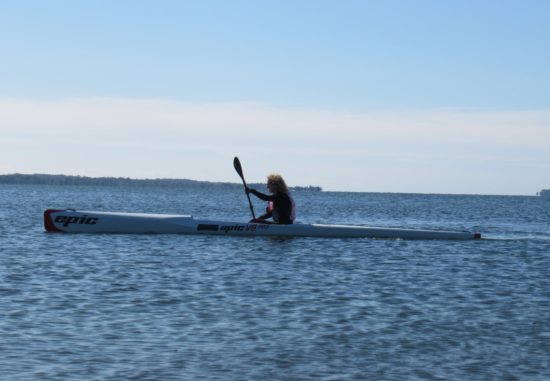
Once I had composed myself and cleaned out my bucket, I took stock of the situation. Tim had made up perhaps 30 seconds in the last 25 minutes, with at least that much time again left in the race. My guess was that at least some of his edge over me was related to his inside line – he was probably getting some modest relief from the wind and tide. But eventually he’d have to abandon this protection and angle out to the more central finish. With my more direct outer line, I reasoned that if I could just keep even with him until he started his cut away from shore, that extra paddling distance would be my cushion of victory. I soon wondered if I’d have enough of a buffer to afford a quick swim. Keeping tabs on Tim by frequently scanning the shoreline over my left shoulder wasn’t helping my stability any.
My sophisticated strategy (that is, paddling in a straight line toward the finish) appeared to be working. Tim didn’t seem to be moving ahead of me appreciably. With a half-mile left in the race, I abandoned my surveillance routine, put my head down, and dashed pell-mell for the finish. My GPS had returned to its habitual deviousness by this point, preposterously insisting that my final sprint topped out at 6.2 mph. I scarcely had time to mute its mocking laughter (am I ever sorry I opted for the Motivation Package) before Tim rolled in behind me – only 30 seconds back. A hard-charging John took third less than a minute later. Wesley and Jim rounded out the top five. In the women’s race, Mary Beth took the gold, Jean the silver, and Melinda the bronze (and a special commendation for scouting out previously unexplored regions of the Sakonnet). Everyone agreed that although the downwind portion of the race was great fun, we’re still gonna get Wesley some day for that grueling upwind slog. Sleep with one eye open and your PFD on, buddy.
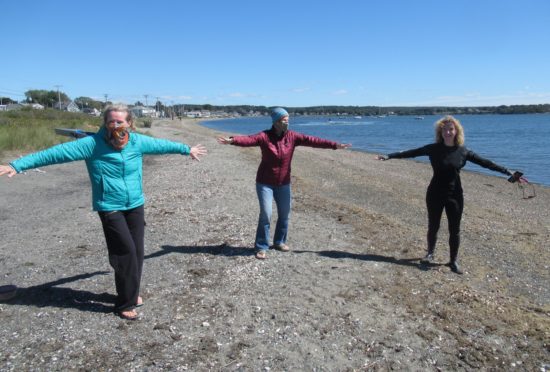
We’re nearing the end of our abbreviated ocean season. The last open-water competition is the Plum Beach Lighthouse Race on October 17. Register early at PaddleGuru to assure yourself a spot. And don’t forget to bring your Rhode Island Ski Season punch card – four races and your social distance requirement will be reduced from six feet to five feet! That may not sound like much of an improvement, but at least it puts your enemies within hockey stick distance.
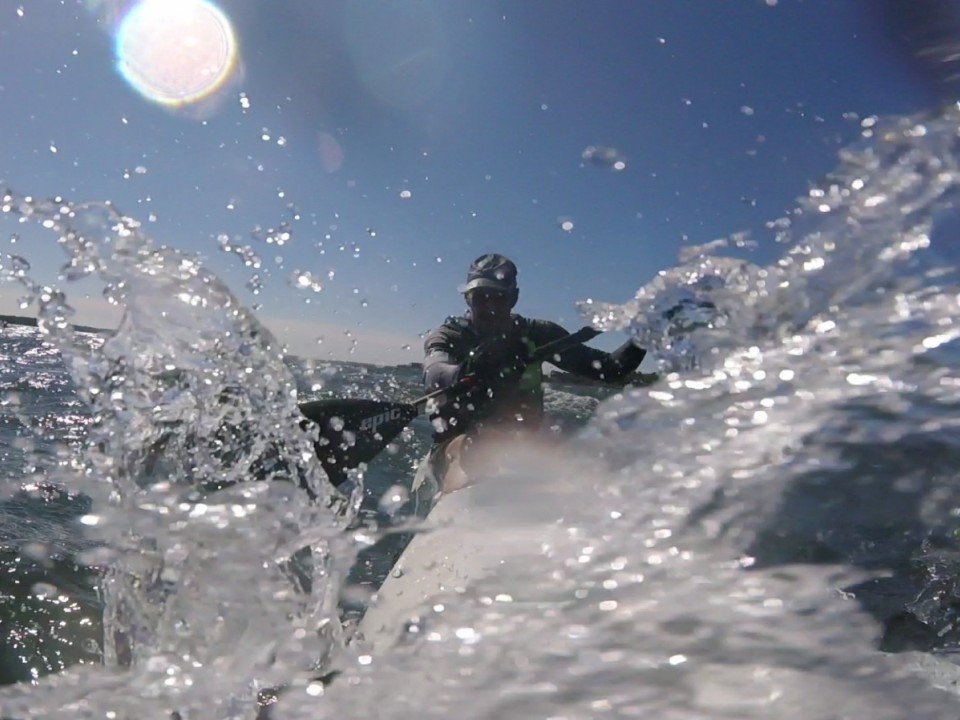
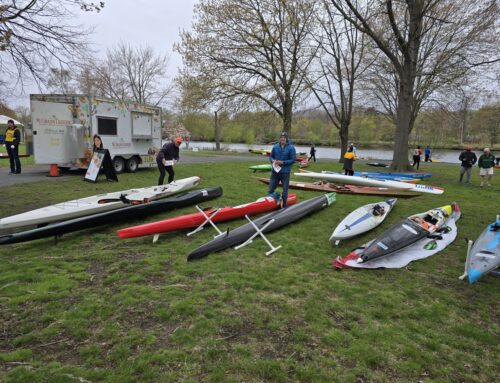
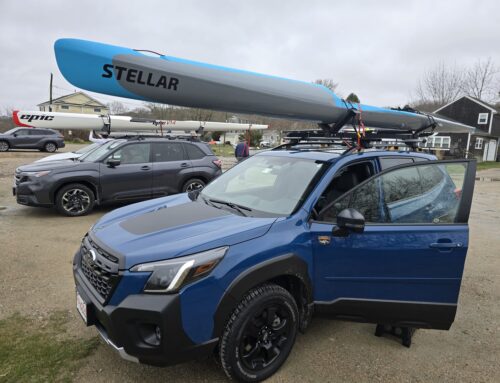
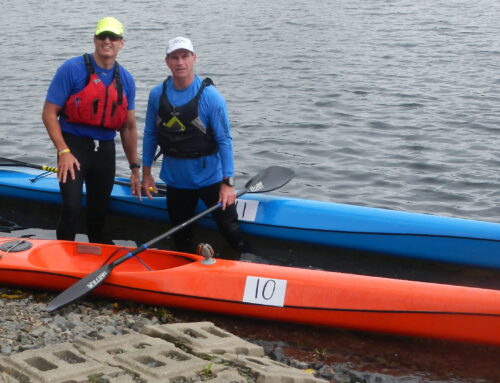
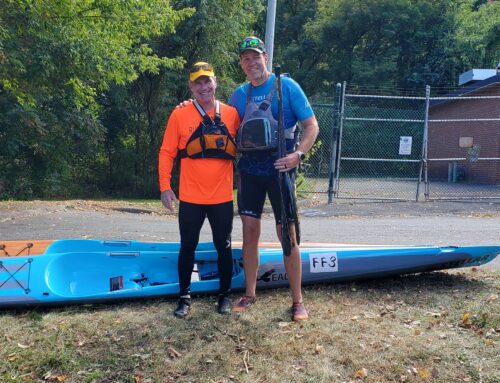
Leave A Comment
You must be logged in to post a comment.